From Steven Spielberg to Martin Scorcese to Guillermo Del Toro, every great filmmaker has a story of how they started. On July 24, Comic Con International Film Festival kicked off the start of the events by inviting a select group of independent filmmakers to discuss their film in a panel discussion. One of these filmmakers was Nicolas Wendl, a young filmmaker who has had his films screened at the Cannes Film Festival three times already. He talks about his film “From the Woods” with me and gives advice to other filmmakers who are pursuing their dream of moviemaking.
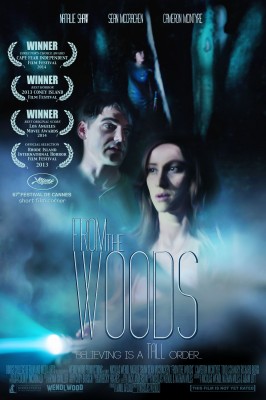
Nicolas Wendl was born in Munich, Germany and raised in the south of France. He discovered his calling in film, where two of his film shorts screened at the Cannes Film Festival while in high school. He then relocated to the United States where he graduated with honors with a degree in film production at Chapman University’s Dodge College. During film school, Wendl produced two acclaimed shorts, How They Smiled (2011) and From the Woods (2013), both starring Richard Burgi. They screened at several festivals across the country, including the Annual LA Indie Film Festival and the Big Bear Lake International Film Festival. From the Woods also screened at multiple horror-genre festivals and won Best Horror at the Coney Island Film Festival.
I want to congratulate you! You recently left Comic Con and were one of the few filmmakers invited to be on the panel to talk about your film From The Woods. How did you get involved in the Comic Con festival?
I heard about Comic Con International Film Festival a couple years ago. There is no fee so there is no pressure to spend and worry if you get accepted or not. So I thought you know what, I’m going to give it a shot. At Comic Con, they are fans of the supernatural elements of the creepy horror genre, and I thought my movie has Slender Man which is a popular character among the “geek” community. So I thought you know what? I’m just going to submit it and see if we find a place for it. I filled out the application in January or February. Then I forgot about it.
When I came back from Cannes Film Festival in May, I thought From The Woods had its run and let’s move onto the next project. A day later I get a letter from Comic Con saying “Congratulations, your film is invited to a screening!” It’s not over yet! By the end of July weekend, the festival coordinator said there was room in the panel. Colin McDonald was my Director of Photography for the film but he was in a shoot that day, so my producer Jamil Afzali and one of the actors Cameron McIntyre came down to be part of the panel with me.

And you had just recently come from the Cannes Film Festival. Now that is exciting.
Yes, the month of May was pretty nuts. Early May I was at the Cape Fear Film Festival in Wilmington, NC where we won the director’s choice award for From The Woods. Then mid-May I flew out to Cannes, France, then I got a letter saying in July we would be in Comic Con. That month was nuts.
That was an incredible run. What was going through your head when you found out you were invited to the Cannes Film festival?
It was my third time going there. It was a strange feeling because it was the first time we were actually able to go there with actors from the film. In the past, I had gone for the film on my own. This time I had the actors with me to celebrate the journey of our movie altogether, which was the most fun part.
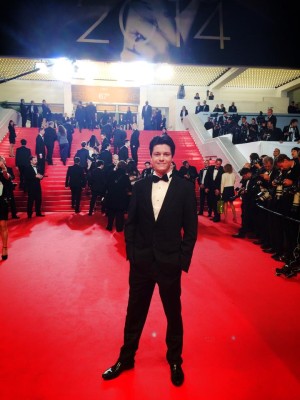
When did you go to the Cannes Film Festival two other times?
I was a junior in high school the first time, and a senior in high school the second time.
That is really impressive. You were in high school and attending the Cannes Film Festival!
Yes (laughing).
What inspired you to direct and write From The Woods ?
I co-wrote the script. It was my idea, but I had a friend of mine who offered to help me out. For me, it was, “What is it that really scares me?” I wanted a fundamental scary element in it, then built the human story around it. This image of a tall skinny image in the distance with a kid in the foreground was terrifying to me. I wanted this to be the center piece of the project but build the human story around it that the audience could relate to and have the Slender Man back there lingering in the back of your head on the side where you can see.
Once I decided the scary element, it was more of what kind of human story do I want to tell. I’m a fan of antagonistic protagonist, where they are their own obstacles in the story. I thought what if I have this mom character who is so blinded by her own fears and concerns about her own life that she basically shuts off any other input about what could truly save her and her son, and runs into a wall? It is the story of this feeble mom who runs away from her abusive husband with her 8 yr old kid to a house in the woods thinking she can start over. She is obsessed about getting her husband out of her life. And that is what ultimately makes her, her own antagonist. Once it is too late, nothing can be done.
You like to work with flawed characters?
I do.
Everybody in the crew was part of Chapman Film School, correct?
Yes, the crew were all Chapman students. From the Woods was my thesis film in college. We had a couple of outsiders helping us on the set that had done some work with the students, but 90% of the crew was from Chapman.
The cinematography was incredible. I loved the shots.
Colin McDonald is my second pair of eyes. He and I have known each other since freshman year. We just clicked so well. I always say we finish each other’s sentence in film terms. We just know what we want to see. We really work well together. It is always a seamless process. Working on a 35 mm for this film was a poetic way to wrap our film studies. It is a dying medium and I thought let’s experience that before it is completely gone. Working with 35 mm, his vision and my vision for the film was really a dream come true.
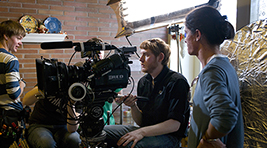
A lot of films are done digitally, but you actually use film stock, right?
Yes, we shot on Kodak 35 mm film with Panavision cameras. It’s pretty pricey, but we got a filmmaker grant at Panavision. We got a lot of equipment from Panavision for nothing. We got student discount rates on both the film and the processing fees, but a) it’s a dying medium b) it’s cheaper as a student, c) as a director and the director of photography, it makes you take the work all that more seriously, because you really have to plan the shots and how things are going to happen.
I’m not saying it’s not going to happen with digital filmmaking. I’m saying there is so much more preparation and precision that goes into making a film with real film. The second the camera rolls, money starts flying. Literally. You can’t just record the rehearsal and go do another take because once you’re out of film, you’re out of film. On digital, you can format the drive and do it again. It really makes you appreciate the importance of saying, “This time we are going for a take. You rehearse your actors before going for a take. That is what that experience has taught me.
Given the pressures of time and money, how did it influence the cast and crew?
It put us all on our toes. The camera was a nightmare to work with. We had to twist the camera body throughout the production because the film wasn’t running through the camera properly. It was punching new holes between the fracket holes which was ridiculous. That put us back by at least 7 or 8 hours just the first weekend just to figure out the camera. That was a big hassle. It definitely drained us. That was a challenge we didn’t account for. Directing and acting is more or less the same. It’s not as easy to go back for a second take as you do with digital. It’s not like we are shooting some big Hollywood blockbuster movie. All of that combined made for a tighter set. It also made it a committed and focused set because we knew how important it was to get it right the first or second time.
Did you do the casting for it or was it a group effort?
I’m a very picky director. Since I had the script in my hands since day 1, I had a specific look in mind for all the characters. It’s always like that with me. I always have a face in mind. I’ve had people tell me I shouldn’t cast on looks, it should be about the performance, but when you post a casting notice on LACasting or CAZT, the first thing you see is the headshot.
When I do auditions, I always like the actors to come in prepared and do the first part of the audition the way they prepared it to see what their take is on it as an actor, then see how I can direct them quote unquote in the second take before I send them away.
For the lead character, I posted dark hair and brown eyes. I would get submissions for blondes or redheads so the first step was to look at who looked what I had in mind visually. I’ll never forget it. When Natalie Shaw came in to audition for Laura Mayfair who was the lead character, I saw her headshot where her hair was too short and she’s wearing glasses. I I decided to give her a shot. She came in with her short hair, glasses on, and she did the kitchen scene which is a very emotional scene for me. It is where she breaks down and lets her guard down. She did that scene in the audition room without me telling anything and she did it exactly the way I envisioned it in my mind. That’s when I knew. I thought let’s give you hair extensions and contact lenses and you’ve got the part.
She was so good. If she was able to read the character off the page with just this one scene, she could nail this entire character. She played such a tough gal in the movie that when I see her in person I forget she’s a sweet, fun bubbly woman. It was a transformation for her.
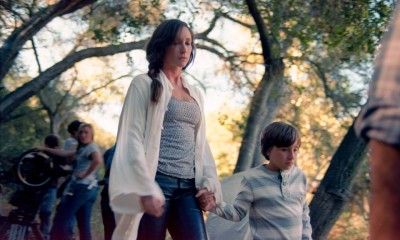
I only had a month to do all the mother/son casting. I had 2 Laura’s and 2 Aaron’s. Natalie & Cameron McIntyre were one pair. Which couple do I take. Their chemistry and how they played off each other was great. I thought I’d be nuts if I didn’t cast them. After the casting, I discovered Natalie grew up right up the hill from where we were shooting. It was like it was all meant to be. She grew up in Topanga Canyon and used to play in the woods as a kid.
When I cast Sean McCracken as Kent Erickson, it turned out Natalie and he both had the same acting coach where Natalie was studying at the Ruskin Theatre School in Santa Monica. What?! Out of all the actors I would cast, they happen to go to the same acting school! It was insane. It is crazy how things worked out with this movie.
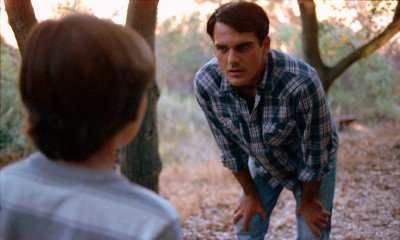
It’s like destiny.
Yes, it was.
Across the board, the acting was great.
I got Richard Burgi from Desperate Housewives was fun. I worked with him on short film the year before. I asked him if he was interested in a small featured character role in the film. He came on board, shot all the elements in one day. It was a lot of fun. He really brought the creepy element to the film.
Let’s talk about your start in filmmaking. You’ve been directing films since even before you were in high school, right?
Yes, I have been directing films since the age of 11. It’s funny how it all started. I started off recording movies with audio tapes. Visually I would imagine images and story lines for a movie. I got hold of my Dad’s video camera and started documenting events. I started shooting the most random stuff. I thought wow, this can do video and audio! I had my action figures and my cousin had her dolls. We would play in the back yard. Those were my first films. Toys were my first actors. I took this seriously. My friends would think oh gosh, we’re going to play with toys and get them filmed. I would write scripts for them. I was serious about that. I would edit them together and put together the music.
During that time, I wanted to become an actor because I wanted to do what the toys do. It was so much fun. Then I realized I prefer telling my friends how to make the toys talk or decide where the camera should be. I asked my Dad, “Is there a job for this?” And he said, “Yes, that is what a director does”. And I thought, “Oh, I want to be a director.” From that day on, I wanted to be a director. From the toys, it went to high school friends to local theatre actors where I grew up in the south of France. In fact, one of them went to Cannes called “There’s something in the air”.
When I came to Chapman to study for college, I went to college friends to use them for my films. I then started going to the professional world using LACasting and CAZT and working with SAG actors. It was an amazing progression.
Did you ever think when you directed your first film with your with toys, that you would be where you are today?
No. I know it sounds cliché, but I didn’t even think of it as a celebrity kind of a job. I get to tell stories and I get to dream and make things up and have things materialize . I never realized that this type of profession puts you in the public eye. It actually is what people call being a star. Now I sort of realize how doing this right and getting recognized makes me famous? It’s weird. For me, I’m a humble person. I don’t see myself as a star. I just love doing what I do. And if it happens to touch people either emotionally or scary or in a funny way, then I’m happy. If people react to a project the way I intended it to, then I did something right. That’s what excites me the most.
Do you have any projects coming up?
Colin and I just wrapped a feature. We are shooting it in two parts. It is called Defriendead. It talks about Asperger’s syndrome and how this young boy has Asperger’s and gets beat up at school and eventually commits suicide because of that. It takes a look at cyberbullying. We have a couple music videos coming out, including artist Stacy Clark and her song “Figure it Out”. That will be in on itunes and on youtube in a few weeks. We have another music video we planned on workng on the next few weeks. We are keeping busy.
Do you have any words of advice for any up and coming filmmakers?
If you really want to express yourself artistically, start off expressing yourself with what you know you can achieve. Don’t try and write things that take place in a spaceship or somewhere in a desert or a skyscraper location if you don’t know if you can do it or not. Do things you know you can make work well, and do them well. Do something small and great versus something big and mediocre to really show what you can achieve. And eventually, things will come to you.
Filmmaking is about investing first, then getting a return on the investment. Knowing what your locations are and pushing right to that boundary is what can help you shine in your best way. I run into projects where people have these big ideas. I’m not saying you can’t dream big. Do a couple of things well versus doing too many things mediocrely. It’s knowing what you can achieve and going all the way with that.
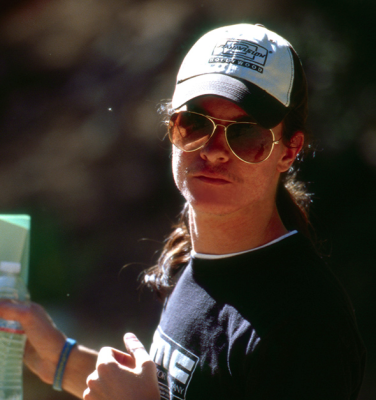
You can check out more on the film From The Woods at:
Official web site: https://www.facebook.com/fromthewoodsmovie
Twitter: @FromTheWoodsMov
You can keep updated on the latest with Nicolas Wendl at Twitter!
Twitter: @NicolasWendl
Courtesy of Wendlwood Productions

1 Comment
Comments are closed.